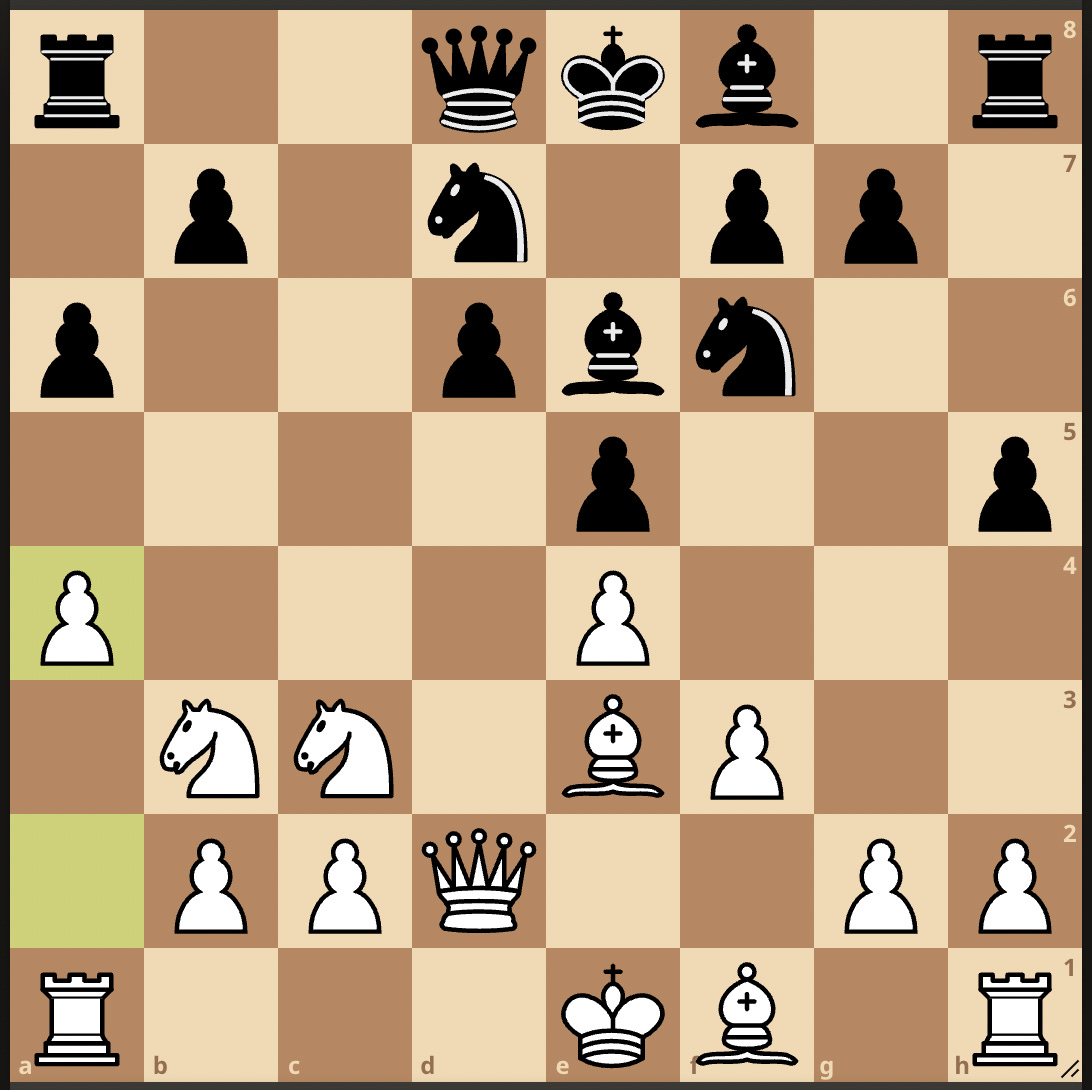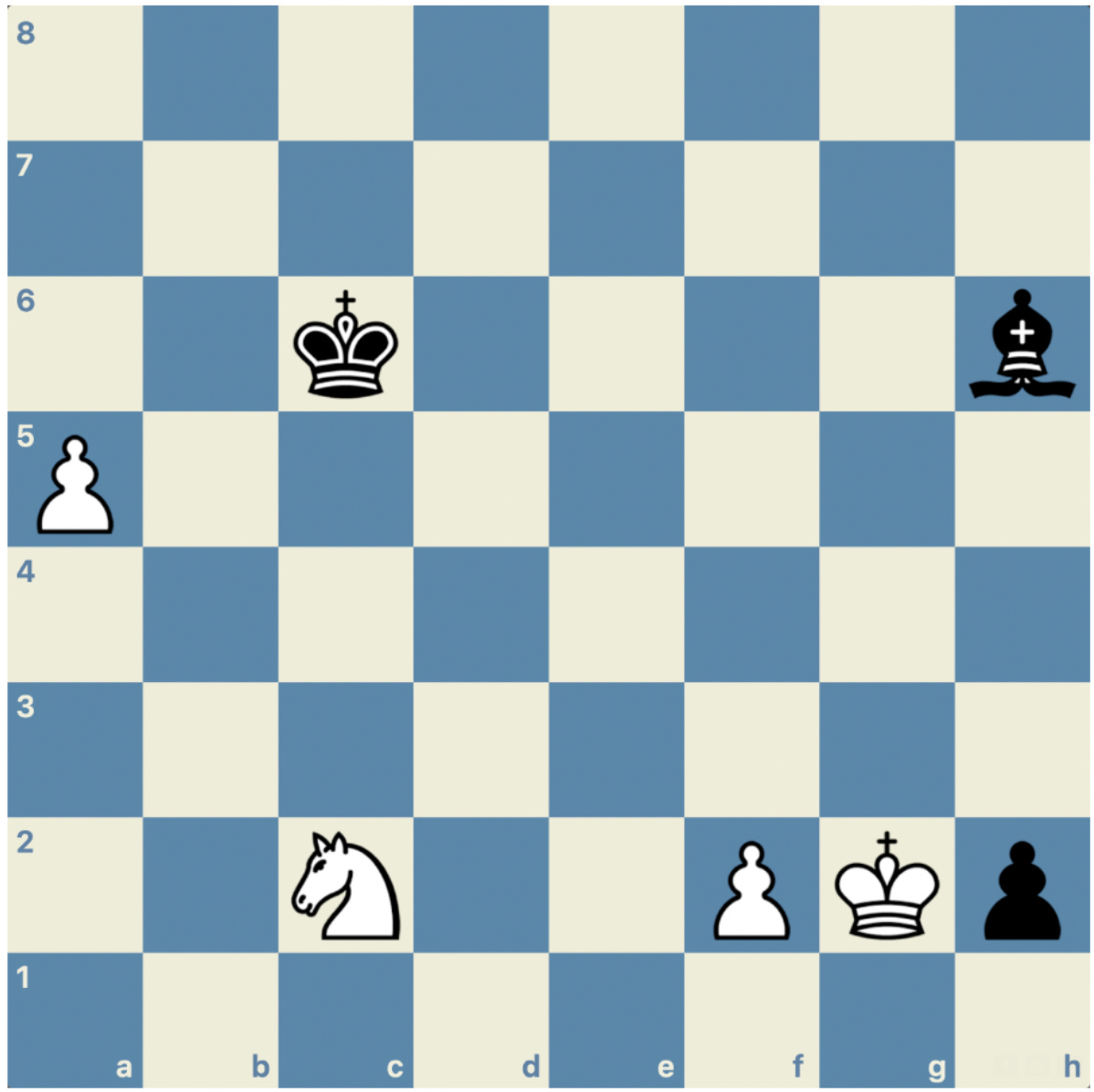In This Issue:
From The Skittles Room
Endgame Corner, by IM Silas Lund
A New Move, by Dr. Frank Brady
My Game at the American Continental, by IM Justin Sarkar
Chess Toons
En Passant
Problem of the Week, by Alexander George
Editor's NoteWelcome back, fellow chess players, to this edition of the Marshall Chess Club's fortnightly bulletin, The Marshall Spectator.
The club’s annual meeting and election was held on June 20th. We would like to congratulate the reëlected and newly elected board members.
The results of the election were as follows:
Sarathi Ray, 61 votes
Ken Kubo, 58 votes
Luka Glinsky, 52 votes
Vladimir Bugayev, 51 votes
John Galvin, 49 votes
There has been a plethora of rated events at our historic club over the last few weeks.
The Under 2000 Morning Action on June 17 had 49 players registered and concluded with a three-way tie for first between Tran Minh Hoang Huynh, Levod Tadevosyan, and Nathan Peyton who scored a perfect 3 out of 3 to win $140 each. No fewer than 9 players shared in a class prize, winning $20 each for their effort: Black Herman, Nicolas Marchese, Albert Li, Aileen Lou, Liam Siu, Raf Goldman, Isaac Noah Lui, Alvin Lou and Avery Whitaker.
The Steve Immitt Action on June 6 had 46 players and featured a two-way tie for first between FM Justin Chen and Paris Prestia who scored a perfect 4 out of 4 to win $162 each. A 7-way tie for the remaining prize left David Bernat, Bryan Weisz, William Safranek, Luc Hoffman, Kole Moses, Narayan Venkatesh and Max Mottola with $15.43 each. Kyle Chan won the $108 class prize, while the upset prize went to Alvin Lou.
The Monthly Under 2400 that concluded on June 18 had a full house, with 69 players registered for the event. IM Justin Sarkar and Nkosi Nkululeko both scored an impressive 4.5 out of 5 share in first place and win $388.13 each. Daniel F Johnston, Aleksandr Gutnik, Aritro Chakravarty and Ciprian Solomon scored 4 points each to win $107.81, while Sasha Schaefer won a class prize of $258.75, scoring 3.5 out of 5, and the following three players won $86.25 each for their performance: Arsen Lahoud, Jeremy Tao and Richard Koppenaal.
The Rated Beginner Open on June 18 had 31 players and concluded with a three-way tie for first between Gorden Hui, Brandon Sweet and Zach Prephan who won $125 each for their perfect scores in the event.
Our Juneteenth Action had an even 50 players registered to play, and was won by FM Brewington Hardaway who scored a perfect 6 out of 6 to take home the $469 first place prize. Second place went to Bryan Weisz who scored 5 points to earn $234, while Paris Prestia and Phineas Weingarten each won a class prize of $141 and the following two players won $70.50: Harper Wallace and Kyle Chan.
The Marshall Masters this month had 25 players registered and concluded with a two-way tie for first place between IM Maximillian Lu and Qindong Yang who scored 4 points each to earn $160. Daniel F Johnston, Leonardo Liu and Kyle Dong all scored 3 out of 4 to take home $53.33 each for their performance.
The Steve Immit Action had 53 players registered and was won by GM Michael Rohde, who took home $244 for his perfect performance, while IM Maximillian Lu and FM Justin Chen won $61 each for their 3.5 out of 4 score, and Luc Hoffman won the class prize of $122. Mitchel Stern, Alec H Choi and Paul Kariuki won $40.67 each for their performance, and Paul Kariuki also won the upset prize in this event.
The Friday Blitz was won by GM Raven Sturt who scored 8 out of 9 to win the $100 first place prize, while FM Gus Huston and Gary Leschinsky each scored 7 points to take home $37.50 each. AIM Tyrell Harriott and Neal Thio Hong scored 5.5 out of 9 to win $25 each, while Mouhamadou Tall and Liam Chan scored 5 points each to earn a $12.50 prize.
The Under 2000 Morning Action on June 23 had 41 players and featured a three-way tie for first between Tran Minh Hoang Huynh, Nathan M Scott and Alexander Soll who each scored perfect 3 out of 3’s to win $166.67 each.
The Game 50 Open on June 24 had 42 players registered and was won by GM Michael Rohde and Jason Jiang who scored a perfect 4 out of 4 to take home $115 each. The remaining class prize of $69 was won by Anthony Brewster for his 3 out 4 score.
The Saturday Game 50 Under 1800 had 23 players registered and was won by Rishan Malhotra who scored 3.5 out of 4 to finish in clear first and take home the $138 prize. Gilberto Astor won a class prize of $69 for his 3 out of 4 score, while Anthony Zhu, Finn Abbott McKeinle and Jesse Lee shared in the remaining place prize winning $30.67 each for their 3 out of 4 performance.
To see the full list of recent results, click here.
Curious who the most active chess players in the last year are? Below are the top 10, but you can see the full list here.
Rank Name Rating # Events
1 CHRISTOPHER WELDON 1508 86
2 MR. JOSE DE VILLA 1901 78
3 LINXI ZHU 1977 74
4 ALEC HYUNMOOK CHOI 1835 66
5 CAMERON HULL 1729 62
6 JOHN WALTON 1600 62
7 ROBERT FANJUN WEI 1383 61
8 AILEEN LOU 1379 60
9 TAKKI TANAKA 1441 58
10 ARTHUR CURRY 1400 58
What’s more, there has been an astounding 24 players who gained more than 100 rating points this past month. To see the full list, click here.
Endgame Corner, by IM Silas Lund
In this Endgame Corner column, I will focus on the Double-Edged Bishop (DEB) and how it is part of the overall strategy in a position, but not the only part. It can be premature to label such a DEB a bad bishop. In fact, such a bishop is often prematurely labelled a 'bad bishop' by commentators simply because it looks bad. I believe that in complex positions that are difficult to immediately grasp, such a bishop becomes an easy culprit and simply labelling a bishop “bad” functions as a substitute for more serious analysis. My 2014 book for Quality Chess, The Secret Life of Bad Bishops, was written with the purpose of rectifying this simplified view. In the diagram position, it is White to move. Take some time to solve it, the solution will follow later.
You can play through the full game and read my analysis in its entirety here.
1. d4 Nf6 2. c4 e6 3. Nf3 d5 4. Nc3 c5 5. Bg5 cxd4 6. Nxd4 e5 7. Nf3 d4 8. Nd5 Be7 9. Bxf6 Bxf6 10. e4 dxe3 11. fxe3 Nc6 12. e4 Bg4 13. Be2 Bxf3 14. Bxf3 Qa5+ 15. Qd2 Qxd2+ 16. Kxd2 Bg5+ 17. Kc3 O-O 18. Rhf1 a5 19. b3 Be7 White to move in the above-diagrammed position.
Here are some quotes about the Double-Edged Bishop from The Secret Life of Bad Bishops that apply to this position:
1) "Double-edged bishop (DEB): A bishop that cannot yet be declared good or bad, but rather holds the potential of becoming good as well as the risk of becoming bad."
2) "Bad Bishop: Analysis of all relevant other factors in the position will show that a bishop has definitely gone from double-edged to bad. "
3) "The DEB is never entirely isolated on its color, since the king is always there to support the other color complex."
20. Nxe7+ (20. Rad1 Bc5 gives Black excellent play on the dark squares.)
20... Nxe7 21. Rad1 Rfd8 Black is fighting for control over the d-file. (Let's see what happens if Black plays 21... Nc6, trying to clog the d-file by jumping to the outpost on d4. 22. Rd7 Rab8 (22... b6 23. Rd6 Due to the b6-pawn, White is again able to get both rooks into Black's position, before Black is able to play Nc6-d4. 23…Rfc8 24. Rfd1 Rab8 25. R1d5) 23. Rfd1 f6 It is important for White to get both rooks into Black's position, before Black is able to play Nc6-d4. (23... Nd4 24. Rd5 with a double attack against a5 and e5.) 24. R1d5 (or 24. R1d6) 24...b6 25. Rc7 Black has troubles dealing with the active White rooks. For instance: Nd4 (Or the following variation that fits in perfectly with the overall strategy that we shall see in the main line of the game: 25... Rfc8 26. Rxc8+ Rxc8 27. Rb5 Rb8 28. c5 bxc5 29. Rxb8+ Nxb8 30. Kc4 With a winning endgame due to White's active king and Black's many weaknesses on the queenside.) 26. Rdd7)
22. Rxd8+ Rxd8 23. Rd1 Rxd1 24. Bxd1
By exchanging off all 4 rooks on the board, White has given his king direct access into Black's position. Thus, what in the starting position looked like a 'good knight versus bad bishop' position, has now turned into a winning endgame for White. And not because White's bishop has improved! The difference-maker here is the active White king, and the bishop still has the role of defender: the black knight is not able to target any of White's pawns. Later on, the bishop will come alive which tells us that it always had potential, and that it was a part of a bigger strategy.
24…Nc6 (24... b6 Here, good is both 25. b4 (and 25. c5 bxc5 26. Kc4)) 25. c5 Kf8 26.Kc4 The main targets are on a5 and b7. In White's position, we can point to a2, e4 and g2 - but they are all on light squares and can be easily defended by the bishop if necessary.
26…Ke7 27. Kb5 Kd7 28. Kb6 Kc8 29. Be2
The bishop comes alive and decides matters for White. The dream squares is d5, aiming at the knight and the vulnerable b7-pawn.
29…g6 30. Bc4 Nd8 31. a4 f5 32. exf5 gxf5 33. Bg8 h6 34. Bh7 f4 35. Kxa5 Kc7 36. Kb5 Ne6 37. h4 Nd4+ 38.Kc4 f3 39. gxf3 Nxf3 40. h5 Nd2+ 41. Kc3 Nf1 42. b4 Ng3 43. Bg6 Kc6 44. Kc4 Kd7 45. b5 Kc7 46. a5 Kb8 47. b6 Kc8 48. a6 bxa6 49. c6 e4 50. Bf7.
A brilliant game by Teodor Regedzinski.
A New Move, by Dr. Frank Brady
From the moment that I climbed the 16 steps up to the Great Hall of the Marshall Chess Club, some 75 years ago, the Marshall became something special for me, and ever since it has also touched my heart.
I am not retiring from the Club, but I am stepping down as a member of the Board of Governors. As one of the oldest members of the Club -- at my next birthday I’ll be 90 -- I want to give a younger member an opportunity to get on to the Board and perhaps take a different perspective than mine and come up with some original ideas from what I had offered to the Club. It’s time for me to weigh anchor, as they say.
However, I will remain as President Emeritus of the club – a lifetime incumbency -- and I hope to continue to offer my advice based on my many years of serving the Marshall, and my extensive experience in the chess world. I have been on the Executive Committee of the US Chess Federation, was the founding editor of Chess Life magazine, am still active as an International Arbiter of FIDE and have directed US Championships, two Women’s Championships, and several Pan-American Intercollegiate events.
I learned a great deal about the Marshall and its players during these years on the Board and it has inspired me to write the history of the Marshall, a book that is scheduled to be published next year.
I would like to take this occasion to thank a few Board members who have been deeply courteous and helpful to me over these years:
Sarathi Ray, our current president, a gentle and efficient leader, who has managed to keep the club afloat during the pandemic and has smoothed out a number of complicated issues as they arose this past year. He is a very strong player, I might add, so be careful if you are ever paired against him.
Sal Matera, an International Master and twice Club champion, currently president of the Marshall Chess Foundation and Vice-president of the club. He has great managerial skills which he displays with finesse: a gentleman par excellence.
Ken Kubo, the Club’s Secretary, and without a doubt the hardest worker on the Board, who among other things keeps us on track by providing us with financial and membership statistics on a daily basis. He is a statistical magician and always willing to help whatever the task.
Jeffrey Tannenbaum, the Club’s Treasurer, the longest-serving board member, who never seems to get tired of my asking about current and past events from the Club’s history. He’s a dear friend to me.
And a special thanks to my fellow Yankee brother, Mike Hehir, who showed me great kindnesses during the Pandemic and always at the Club for which my wife Maxine and I will always be grateful.
And to all the other members of the Club and the Board, I sincerely thank you for assisting and encouraging me in so many ways.
God, I love this Club.
God, I love this game!
My Game at the American Continental, by IM Justin Sarkar
I did well at the American Continental held in Juan Dolio, Dominican Republic, which was my first time in the Caribbean after such a long time. After a fine round 2 draw with Black on board 1 against top seed GM Jorge Cori (2650), I struggled in the middle, but then turned things around to end on a high note with 7.5/11 and a tie for 11th through 16th place. This comeback involved beating 2 GMs rated over FIDE 2500. I'll annotate the last round game.
Having ASD, as can be seen from the Autism Awareness night at the Marshall the other month, gives me some extra challenges. I like to "fit in" and feel liked, without having to "hang out" or converse at length. Frequently struggling with people interaction, my secret to feeling better lies in "very simple" exchanges or friendly gestures such as briefly greeting fellow players who I face. It has helped to say my name aloud to new faces I meet, especially at the chessboard, while slightly varying my verbal greeting from person to person and not initiating more than one or two new greetings a day. This personal touch is surprisingly new relative to how long I've been playing chess and has begun to click. Moreover, I think you can relate to the point that sometimes "simple things" can be powerful. If I have the chance to meet or play against you in a future tournament, I want you to know that even if I may not seem overly talkative, I still value the stimulation of being around people.
Here's my final round win over GM Santiago Avilas Pavas (FIDE 2522). This happened to be a new young fellow who I was happy to meet and I gave a brief (3 to 5 seconds max.) verbal greeting as desired upon his arrival at the board, adding a slight personal touch to the standard pregame handshake. Let's see how my chess play did the talking:
GM Santiago Avilas Pavas (2522) - IM Justin Sarkar (2320), XVI Campeonato Continental Absoluto de Ajedrez de Las Américas 2023 Round 11 (5/23/2023)
Play through the game here.
1.e4 c5 2.Nf3 d6 3.d4 cxd4 4.Nxd4 Nf6 5.Nc3 a6 This was my first big chess decision. I play many different opening lines. I tend to have a good memory but it can be kind of scattered in different places. At the same time, I often aim for principled chess and not being one to shy away from a sharp fight. Actually something about it being the birthday of GM Igor Novikov (and a day before mine) who I used to know, who's a big advocate of the Sicilian Najdorf, inspired me to go for a Sicilian Najdorf in the event of facing 1.e4. It can indeed lead to a complex fight, which I think suited both me and my opponent in this final round game, and is not exactly for the faint-hearted. 6.Be3 I half expected this move, as I saw he had played it before. This was a 10:30 AM game and I tried to briefly look at various other lines, especially trying to take note of those that had been played earlier in this event by other strong players in the Najdorf. e5 7.Nb3 Be6 8.f3 This is the sharp and principled English Attack, which I kind of expected him to go for after playing 6.Be3. h5 9.Qd2 Nbd7 10.a4
This is only the third most popular move, with 10.Nd5 or 0-0-0 being much more common. I was vaguely aware he played a recent game with this move but was kind of unsure if he'd repeat it, with me being no less focused on the 2 main moves from this position in my limited time and attempts to prepare. Rc8 11.a5 Be7 12.Be2 His aforementioned game happened to be from earlier in this event. Here his opponent castled, which can't be so bad, but after 13.0-0 Qc7 14.Rfc1, White soon got a pull and went on to beat his lower rated opponent handily in Avila Pavas (2522) - Avila Rodriguez (2240), Juan Dolio (4) 2023. g6!? This was kind of over the board inspiration, motivated by something I'd recently seen in a book. More on that later. It's a kind of sophisticated waiting move, not quite showing my hand while keeping options a bit open with my king as you're about to see. 13.0-0 His decision with the king to play 0-0 seems kind of obvious. Kf8!? Now I choose to "castle by hand", putting the king on g7 and figuring my h8-rook may remain useful on the h-file for now. As it so happens, we transposed to the game Haast (2352) - Shankland (2652) from Wijk 2015. Black can also consider 13...h4, delaying committing the king for one more move, which Vigorito mentions as a fully playable alternative. 14.Nd5 A logical move and change to the position Bxd5 15.exd5 Kg7
Or first 15...h4!? 16.c4! A logical improvement over the Haast-Shankland game. In fact, IM David Vigorito quoted that game, which we transposed to, in part of his chapter on the English attack. Against GM Sam Shankland in 2015, Anne Haast played 16.Ra4?! which was met by 16...b5! Black went on to win, with a good position and 300 point rating advantage. In Vigorito's book from a few years ago, he described 16.Ra4 as "a bit exotic" and himself suggested 16.c4! So in this game I took a page from Vigorito's book. h4 My knowledge ended here. Funnily, we've transposed to a game Erenburg (2520) - Nakamura (2570), from Reykjavik 2004, which White went on to win. Vigorito gave one or two lines from this position, with chances for both sides. My opponent thought for a little while and played an interesting novelty that I kind of considered... 17.f4!? Even if Black is supposed to be OK somehow I was kind of concerned about this move and wondered what to do. Ne4!? Seeking activity and perhaps double edged play. I felt the only decent alternative was to take on f4 but something about it did not quite appeal to me, so after taking some time I just chose to play knight to e4 and hope for the best. 18. Qc2 f5 This was my idea and the only consistent follow-up. 19.Bf3 Ndf6 20.Rfd1 Qd7 21.Rac1 This was probably the critical point of the game and my longest think. I got quite worried about my position, having to watch out for him taking on e5 and playing c5, crashing through with his queenside pawn majority and initiative before I can get enough play with my central mass. I can't recall what exact lines or moves I considered but after a bit of back and forth I came around to deciding between the move I played and 21...exf4. I rejected the latter on general principle that after 21...exf4 22.Bxf4 it felt scary to give his knight quick access to the e6 square with Nd4 followed by Ne6 soon coming. 21...Rhe8!? I have a feeling this was a mistake, but it worked surprisingly well, when he in turn took a very long think and then soon went astray. Based on the computer eval, I should've just taken on f4 with 21...exf4 22.Bxf4 and now play ...Bd8. I guess that's a kind of computer move. Eyeing the a5 pawn if he moves his knight and also if he plays 23.Nd4 I have the option of 23...Nxd5 as his c-pawn is pinned. The position is equal or unclear. 22.fxe5 This is an obvious and critical move, which I kind of expected. Somehow I neglected to consider the immediate 22.c5! I have no good way to capture on c5 as e5 hangs and my position falls apart. However, the sequence 22...exf4 23.c6! (White's idea) bxc6 24.dxc6 Rxc6! 25.Qxc6 fxe3 sacking the exchange for a pawn, may actually be playable for Black. Of course I did not consider any of this. dxe5 23.c5? I also considered and was concerned about this, but actually it's flawed, as my idea simply works. Another move like 23.Qd3 was preferable. Nxd5! My idea, simply being to take his pawn on d5. 24.Bxe4 fxe4 25.Qxe4 Rcd8! My problems with a pin on the d-file are an illusion. The position has transformed in my favor. He has passive pieces, pawns going nowhere, and no way to attack my knight on d5 with another piece. And my e5 pawn is poisoned, as 26.Qxe5+ loses on the spot to ...Bf6. 26.Bf2 Qf5!
A neat tactic, radically solving the problem of the d5-knight pin and trying to drive his centralized queen away or force him into a nice endgame for me. Suddenly things are looking very good for me. 27.Re1 He does not want to strengthen my pawns by exchanging on f5 but ends up having to do so anyway. Nf4! Now my knight is looking for nasty "family forks". 28.Qxf5 28.Qxe5+? Qxe5 29.Rxe5 Nd3 is even worse for White. gxf5 29.Rxe5?! This is a desperate exchange sac, but his position was kind of falling apart. He should probably try something like 29.c6 bxc6 30.Rxc6 at least keeping material equality for the time being. 30...Nd3 (or maybe even stronger is 30...h3 first followed by ...Nd3) then looks attractive. Nd3 30.Rxe7+ Rxe7 31.Rd1 Red7 Or 31...Rd5! With idea 32.Bxh4 Re2 or 32.Bd4+ Ne5. 32.Bxh4 Nxb2! This was my idea. 33.Rf1 He was already very low on time but unfortunately I kind of caught up with him on my next move. Re8! Activity (and a rook trade) first, forget about the f-pawn. I hate to admit debating over whether to do this or just save my f-pawn with 33...Rf8. I came around to choosing 33...Re8 more due to liking it rather than actually spotting a concrete flaw with 33...Rf8 in 34.c6! bc6 35.Nc5 and amazingly he'd win the exchange back by force, with a fork on e6 or e7. Whereas 33...Rc8 was a decent alternative. 34.Rxf5 Rd1+ 35.Rf1 I can't even recall what I wanted to play on 35.Kf2 but it looks like I have a few good options. Rxf1+ 36.Kxf1 Nd3!
This should be a technical win as he can't really hold his queenside pawns for much longer and his g,h pawns are quite slow. But I was quite low on time too and had to watch out for potential counterplay with his connected passers while I go about taking his queenside pawns and creating a passer of my own. 37.Bg3 Re4 38.Nd2 Ra4 39.Bc7 Nxc5 40.Ke2 The time control was G/90 plus 30 second increment per move, so there was no extra time added after move 40. For the time being, his a5 pawn holds back my a+b pawns, so it's essential for me to find a way to capture it. Ne6 41.Bb6 Nf4+! 42.Kf3 Nd5 43.Bd8 Kf7 44.Ne4 Ke8 Finally the a5 pawn will have to go. 45.Bg5 Rxa5 46.h4 Ra3+ 47.Kg4 a5!? This was perhaps a bit fancy and actually I at least caught up with his time pressure on this move. There's nothing wrong with the obvious 47...b5! Keeping both of my pawns so not having anything to calculate there, and for now letting the b-pawn be the frontrunner. Yet somehow I was so fixated on the idea of using my a-pawn, as I felt I could've gotten such a position anyhow without the b-pawn and felt the outside passed a-pawn alone would be very fast. This should work too and I guess it's a matter of taste. 48.h5 On 48.Nd6+ Kf8 49.Nxb7 a4 he's soon likely to give up a piece for the a-pawn. Kf7!? Taking a move to bring my king closer to stopping his h-pawn, while again not worrying about 49.Nd6+ followed by 50.Nxb7. 49.Kf5 Ne3+!? 50.Ke5 Nxg2 Seeking clarity by removing his g-pawn, while still banking on my a-pawn, even though I could've pushed it immediately in the last few moves. 51.Nd6+ Kg8 52.Nxb7 a4 53.Nc5 Rg3 54.Bf6 a3 55.Ke6 Nf4+ 56.Kf5 Nxh5 57.Be5 Re3 58.Bd4 a2 59.Kg5 Ng7 60.Kg4 Re1 61.Nb3 Re4+ Followed by 62...Rxd4. White resigned 0-1
I got the job done and scored a big win in a key last round game. This was a nice birthday present. I can't over stress the importance of being in a good state mentally. I have to keep figuring out how to do so and maintain such a state. We all have our own answers and coping mechanisms. And yes, "simple things" can be powerful.
Chess Toons
En Passant
Teenager Alice Lee sets new landmark for US Women’s Chess after online feats.
Who would have seen this coming before 2020, The Queen’s Gambit, and the rise of chess as an esport? Chess.com, the world’s leading chess platform, has been named in TIME’s prestigious 100 Most Influential Companies of 2023 list.
Ray Robson joined Vincent Keymer in the lead of the Prague Masters tournament after beating Boris Gelfand in what turned out to be the only decisive game of round 3.
New Marshall Merch!
Many of you know Marshall parent, George Skelcher, who has contributed some wonderful art to The Marshall Spectator and to our social media in the past few months. Many of you have suggested that we put this great art on T-shirts, mugs and other things, so we did.
First in our Artist series is this coffee mug. Click the image to order one for yourself! When you wear Marshall Chess Club gear or drink out of a mug, you are helping to promote the club!
Proceeds net of cost will go to the artist as we love to support our community!
Order yours now! Members can get a 20% discount by using the coupon code “marshall2022”.
Problem of the Week
Sam Loyd, 1859
White to mate in 5.
For the next few weeks, we'll explore miniatures, chess problems with fewer than seven pieces. It is simply astonishing how much beauty and interest can be squeezed by talented minds out of such minimal material. (These problems will be drawn from Colin Russ' fine collection Miniature Chess Problems.)
It's fitting to begin with this offering from the Puzzle King. White will have to shuffle his pieces just so as the Black pawn counts down the time.
---
Richard Reti, 1922
Solution to Réti, 1922: 1.Nd4+. (If 1.Nb4+ Kb5, 2.a6 Kb6 and the white pawn is a goner after the bishop plays to f8.) 1...Kc5. It's difficult to see how White can improve his position. In fact, he can't. But Black has no improving moves either. So White just waits with the beautiful 2.Kh1!! The only Black king move that doesn't allow the a-pawn to run is Kd6 - but then 3.Nf5+, winning the bishop. All bishop moves lead a similar fork, except Be3 (after which the Bishop is gobbled by the pawn). Have you ever seen a quieter winning move!?
Editor's Note
Notice anything different about this newsletter? We switched platforms. While Mailchimp has served us well, as our subscribers increased so has Mailchimp's pricing. More importantly, the editing interface created several issues that caused us to consider alternatives. We found Substack and decided to give it a shot. Substack is free and allows for easy browsing of older issues. We hope you like it as much as we do.
As always, if you have any feedback, comments, or would like to submit an article please contact us directly at td@marshallchessclub.org.
Enjoy, and thanks for reading!
The Marshall Chess Club
23 West Tenth Street New York, NY 10011
212.477.3716



















